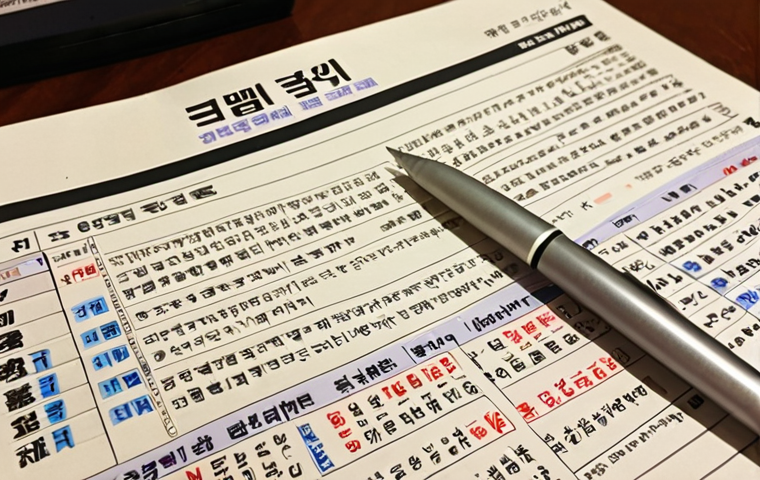So, you’re thinking about diving into the world of TOPIK exams, huh? Well, buckle up, because it’s a journey filled with Korean grammar, vocabulary, and enough listening practice to make your head spin – in a good way, of course!
I’ve seen so many people get overwhelmed, but with the right approach, anyone can totally ace it. Personally, I found breaking it down into manageable chunks and focusing on my weaknesses really helped.
The latest trend shows a rise in online resources, making prep way more accessible than ever before. In the future, expect AI-powered tools to provide personalized feedback, which will be a game changer.
Let’s delve deeper and get you prepped!
Alright, let’s get this TOPIK prep blog post rocking with some seriously useful and engaging content!
Decoding the TOPIK Test Structure

Understanding the format is half the battle. I remember when I first started, I was totally clueless about what to expect. I spent hours just figuring out the different sections and question types.
Don’t make the same mistake! TOPIK, or the Test of Proficiency in Korean, is broken down into two levels: TOPIK I and TOPIK II. TOPIK I is for beginners and lower-intermediate learners, while TOPIK II is for intermediate to advanced learners.
Knowing which level to aim for is crucial.
1. TOPIK I vs. TOPIK II: What’s the Difference?
- TOPIK I includes Listening and Reading sections, focusing on basic vocabulary and grammar needed for everyday conversations. It’s more about understanding simple sentences and dialogues.
- TOPIK II, on the other hand, includes Listening, Reading, and Writing sections. It tests your ability to understand complex texts, participate in detailed conversations, and write coherent essays. The grammar and vocabulary are significantly more advanced.
2. Navigating the Sections
- Listening: This tests your ability to understand spoken Korean. You’ll hear conversations, news reports, and lectures. Pay attention to context and intonation to catch the nuances.
- Reading: This section assesses your comprehension of written Korean. You’ll encounter various texts, from advertisements to academic articles. Skimming and scanning are your best friends here.
- Writing (TOPIK II only): This part requires you to write two essays: one explaining a given topic and another presenting your opinion on a specific issue. Clear structure and persuasive arguments are key.
Mastering Essential Grammar Points
Grammar can seem intimidating, but it’s the backbone of any language. I used to dread grammar drills, but then I realized that understanding grammar rules makes everything else – reading, writing, speaking – so much easier.
Focus on the high-frequency grammar points that appear often in TOPIK exams.
1. Top Grammar Patterns to Know
- -(으)ㄹ 거예요: Expressing future intentions or plans. It’s like saying “I will” or “I’m going to.”
- -고 있다: Describing an ongoing action. Think of it as the “-ing” form in English.
- -아/어/여서: Indicating reason or cause. It’s similar to “because” in English.
2. How to Practice Grammar Effectively
Flashcards are your best friend! Create flashcards with grammar points on one side and example sentences on the other. Use them regularly to reinforce your knowledge.
Don’t just memorize the rules; understand how they’re used in context. Look for patterns in sentences and try to create your own examples. This helps you internalize the grammar and use it more naturally.
Expanding Your Korean Vocabulary
Vocabulary is the building block of language. The more words you know, the better you’ll understand and express yourself. I used to carry around a notebook filled with new words, and I’d review them whenever I had a spare moment.
It sounds old-school, but it worked wonders.
1. High-Frequency Vocabulary Lists
- Prioritize learning the most common words first. These are the words that appear most frequently in everyday conversations and texts.
- Focus on vocabulary related to common TOPIK themes, such as daily life, work, education, and current events.
2. Effective Memorization Techniques
- Use flashcards, but make them interactive. Write example sentences, draw pictures, or create associations with the words.
- Read Korean newspapers, magazines, and books. Highlight new words and look them up in a dictionary. Try to guess their meaning from the context first.
- Watch Korean dramas and movies with subtitles. Pay attention to the words used by the characters and try to use them in your own conversations.
Perfecting Your Listening Skills
Listening can be tough, especially if the speakers talk fast or use unfamiliar accents. I remember feeling so frustrated when I couldn’t understand a word they were saying.
But with consistent practice, you’ll start to pick up on the rhythm and intonation of the language.
1. Active Listening Strategies
- Don’t just passively listen; actively engage with the audio. Try to predict what the speakers will say next, and take notes as you listen.
- Focus on keywords and context to understand the main idea. Don’t worry about understanding every single word; just try to get the gist of the conversation.
2. Resources for Listening Practice
- Listen to Korean podcasts and radio programs. There are many great options available online, covering a wide range of topics.
- Watch Korean news reports and documentaries. This will expose you to different speaking styles and accents.
- Use TOPIK listening practice materials. Many websites and textbooks offer practice tests with audio recordings.
Sharpening Your Reading Comprehension
Reading is all about understanding the writer’s message. I used to struggle with long, complicated texts, but I learned to break them down into smaller, more manageable chunks.
Focus on identifying the main idea and supporting details.
1. Reading Techniques for Speed and Accuracy
- Skim the text to get an overview of the main topics. Then, scan for specific information that you need to answer questions.
- Pay attention to keywords, phrases, and transition words that indicate the flow of the text.
2. Practice with Authentic Materials
- Read Korean newspapers, magazines, and online articles. Choose topics that interest you to stay motivated.
- Read Korean novels and short stories. This will help you improve your vocabulary and grammar in a fun and engaging way.
- Use TOPIK reading practice materials. These materials are designed to simulate the actual test format and difficulty level.
Conquering the Writing Section (TOPIK II)
Writing can be daunting, but it’s also a great way to showcase your language skills. I used to be terrified of writing essays in Korean, but I learned that with practice and a clear structure, anyone can write a decent essay.
Focus on organizing your thoughts and expressing them clearly and concisely.
1. Essay Structure and Organization
- Start with a clear introduction that states your main point. Then, develop your ideas with supporting evidence and examples. Conclude with a summary of your main points and a concluding statement.
- Use transition words to connect your ideas and create a smooth flow. Make sure your essay is well-organized and easy to read.
2. Practice Prompts and Feedback
- Practice writing essays on a variety of topics. Ask a native speaker or a Korean teacher to give you feedback on your writing.
- Pay attention to your grammar and vocabulary. Use a dictionary and grammar checker to correct any mistakes.
- Read sample essays to see how other writers have approached the same topic. Learn from their techniques and incorporate them into your own writing.
Here is a sample table structure containing useful resources.
| Resource Type | Description | Link/Source |
|---|---|---|
| TOPIK Official Website | Official source for test information, registration, and sample questions. | |
| KoreanClass101 | Offers audio lessons, vocabulary lists, and grammar explanations. | |
| How to Study Korean | Comprehensive grammar lessons and vocabulary lists. | |
| Memrise | Flashcard app with user-created courses for Korean vocabulary and grammar. | |
| Anki | Spaced repetition flashcard system for efficient vocabulary memorization. |
Test-Taking Strategies and Time Management
Even if you know the material, you need to be smart about how you take the test. I’ve seen so many people run out of time or make silly mistakes because they weren’t prepared for the test-taking environment.
1. Pacing Yourself
- Divide the total time for each section by the number of questions to get an idea of how much time you have per question.
- Don’t spend too much time on any one question. If you’re stuck, move on and come back to it later if you have time.
2. Dealing with Test Anxiety
- Take deep breaths and try to relax. Remember that it’s just a test, and you’ve prepared as much as you can.
- Focus on the questions you know and build your confidence. Don’t let the difficult questions psych you out.
- If you start to feel overwhelmed, take a break and refocus. Close your eyes, take a few deep breaths, and remind yourself of your goals.
Wrapping Up
So, that’s a wrap on prepping for the TOPIK! Remember, consistency is key. Don’t cram the night before; instead, set aside time each day to practice and review. Trust your instincts, stay calm, and you’ll do great. Good luck with your studies and your test!
Handy Information to Know
1. Local Language Exchange Groups: Find language exchange groups in your city. It’s a fantastic way to practice speaking and listening with native speakers in a casual setting. Check out platforms like Meetup.com or local university bulletin boards.
2. Public Libraries: Libraries often offer free language learning resources, including textbooks, audio materials, and online courses. Some even have language learning software available for patrons.
3. Community Centers: Many community centers offer affordable language classes. These classes are usually taught by experienced instructors and provide a structured learning environment.
4. Local Korean Restaurants and Shops: Immerse yourself in Korean culture by visiting local Korean restaurants and shops. Practice ordering food in Korean or try reading Korean newspapers or magazines while you’re there.
5. Language Learning Apps: Supplement your studies with language learning apps like Duolingo, Babbel, or Rosetta Stone. These apps offer interactive lessons and gamified exercises to make learning fun and engaging.
Key Takeaways
Here are some essential points to keep in mind as you prepare for the TOPIK:
– Understand the TOPIK test structure (TOPIK I vs. TOPIK II) and format.
– Master essential grammar points and vocabulary related to common TOPIK themes.
– Practice active listening and reading techniques to improve comprehension.
– Develop a clear and well-organized essay structure for the writing section (TOPIK II).
– Implement effective test-taking strategies and time management to maximize your performance.
Frequently Asked Questions (FAQ) 📖
Q: Okay, so the TOPIK exam sounds daunting. Where do I even begin studying, especially if I’m juggling work or school?
A: I totally get that feeling of being overwhelmed! When I first started, I felt like I was staring at a mountain of Korean textbooks. What really worked for me was starting small.
Instead of trying to cram everything at once, I dedicated 30 minutes each day to learning new vocabulary. Think of it like building a vocabulary bank, little by little.
Then, I’d use language learning apps like Duolingo or Memrise during my commute or lunch break for some extra practice. Also, don’t underestimate the power of K-dramas and Korean music!
Watching shows with subtitles and listening to songs can help you get a feel for the language’s rhythm and pick up new phrases naturally. Trust me, even passively absorbing the language helps more than you think.
It’s all about finding what fits into your routine and sticking with it! It’s a marathon, not a sprint.
Q: What’s the deal with the different TOPIK levels? How do I know which one to aim for, and what if I fail?
A: That’s a super valid question! The TOPIK levels can be a bit confusing at first glance. Basically, there are two exams: TOPIK I (levels 1-2) and TOPIK II (levels 3-6).
Level 1 is the most basic, while level 6 is the most advanced. A good starting point is to realistically assess your current Korean skills. Can you hold a basic conversation?
Can you read simple texts? If you’re a complete beginner, aiming for TOPIK I might be a good idea. If you’ve been studying for a while and can understand most of what’s going on in Korean dramas, maybe TOPIK II is a better fit.
There are tons of online practice tests you can take to get a sense of your level. As for failing, honestly, don’t sweat it! Think of it as a learning experience.
Use it as an opportunity to identify your weak areas and focus on improving them. Plenty of people don’t pass on their first try, and that’s totally okay!
The key is to not give up and keep practicing.
Q: I’m really struggling with the listening section.
A: ny tips on how to improve my Korean listening comprehension for the TOPIK? A3: Oh, the listening section… a lot of people find that tricky!
I know I did! The biggest thing that helped me was active listening. Instead of just passively hearing the audio, I’d try to focus on key words and phrases.
Start with easier materials like children’s shows or beginner-level podcasts. Then, gradually work your way up to more challenging content. Another really effective technique is to transcribe what you hear.
Write down as much as you can, even if you don’t understand everything. Then, compare your transcription to the original text and see where you made mistakes.
This will help you identify common sounds and pronunciations that you’re missing. Don’t be afraid to rewind and listen to the same section multiple times.
Also, find a language exchange partner or tutor who can speak Korean fluently and practice listening and responding to them in real-time. Exposure is key!
The more you listen, the better you’ll become. And remember, patience is key! You’ll get there eventually!
📚 References
Wikipedia Encyclopedia
구글 검색 결과
구글 검색 결과
구글 검색 결과
구글 검색 결과
구글 검색 결과


